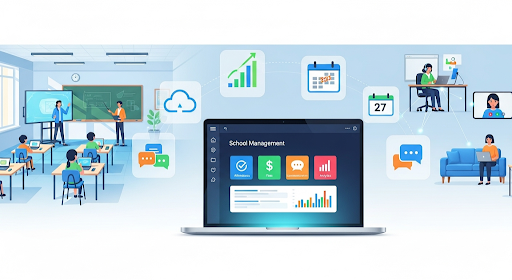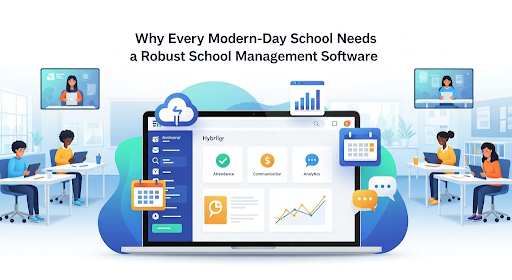In the last ten years, the function of education has changed a lot. Schools today have more than just classrooms, chalkboards, and paper registers. They work like complicated businesses with many different jobs, such as admissions, attendance, tests, communication, money, and more. Parents want updates right now, instructors want better tools, and administrators need things to run smoothly.
In this new world, a school management system is no longer an optional upgrade; it is the basis for a contemporary school. It gives schools the framework they need to run successfully and lets them teach without any interruptions.
Did You Know? According to HolonIQ, global spending on education technology is projected to hit $404 billion by 2025.
This isn’t just a statistic—it’s a signal. Schools that invest in digital solutions today are setting themselves up for long-term success, while those that hesitate risk falling behind.
Why outdated school administration methods slow down progress
Many schools still use old tools, such as manual registers, scattered spreadsheets, or legacy systems. These may keep things operating, but they add up to a lot of hidden expenditures.
For administrators, it means spending hours trying to make sense of data. For instructors, it means having to deal with paperwork instead of teaching. For parents, this frequently means that they don’t get important updates on time. These problems get worse with time, leading to dissatisfaction and missed chances.
Why conventional systems slow growth:
- Student statistics and reports often include mistakes.
- Tracking attendance and fees is not very efficient.
- Costs grow because of manual methods
- Staff and parents talk to each other more slowly.
Schools that use new digital platforms rapidly learn how much time, money, and energy they can save.

How cloud-based school software makes education more accessible
Cloud-based school software is transforming the way schools work as hybrid and remote learning becomes the new normal. It lets administrators, instructors, students, and parents get information whenever and wherever they choose, and the data is stored safely so that it can’t be lost.
Cloud-based platforms make it possible for learning to continue without obstacles by connecting everything from getting grades at home to making reports in real time at work.
Some of the main benefits of cloud-based solutions are:
- Access from any device at any time of day or night
- Lowered expenses for physical IT infrastructure
- Updates in real time on all platforms
- Features that may develop with the school
Schools that use cloud solutions are better able to handle abrupt changes, such as a rise in enrollment or the need for remote learning.
Why an education management platform improves student performance
People often think that management software simply helps administrators, but an education management platform has a direct effect on pupils. Teachers may find kids who are having trouble far sooner if they keep track of their performance data, attendance records, and tests in one place.
Parents also get more information and don’t have to keep asking for it. When children, instructors, and parents are all part of the same ecosystem, performance automatically becomes better.
How it affects students:
- Analytics help teachers make lessons more personal.
- Early help with school problems
- Clear communication between schools and families
- More motivation because of constant feedback
Why school management software is the backbone of modern institutions
A good school management software solution makes key tasks that used to be too hard much easier. It combines several tasks into one system, from admissions to managing tests.
Schools used to have to use five different platforms for attendance, financing, communication, schedules, and reporting. Now, they use just one platform that works for all of these things. This concentration is what makes operations great.
Management software supports these main areas:
- Automatic reminders and collection of fees
- Managing student records from one place
- Smart schedules and calendars
- Dashboards for administrators that are based on data
Schools that use this method run more smoothly, enhance staff morale, and gain the trust of parents.
How an attendance management tool keeps schools accountable
Keeping track of attendance may seem like a simple thing, but it has a big effect on discipline and grades. A digital attendance management tool makes sure that the information is correct and avoids mistakes that can happen with paper registers.
Parents may be told right away if their child skips class using real-time tracking. Attendance data also shows patterns over time, which helps schools step in before too many absences hurt grades.
Advantages of automatic attendance:
- Updates in real time for parents and teachers
- Analytics on trends and patterns in absenteeism
- Getting rid of fraudulent or proxy attendance
- Digital documents that are easy to follow
This feature makes sure that teachers are responsible for their work and frees them from having to do the same thing over and over again.
The impact of School Management Software on reputation and growth
Adopting a reliable school management software system isn’t just about efficiency; it directly shapes the school’s reputation. Parents want open schools and try new things.
Modern software makes sure that parents get information right away, that payments go quickly, and that communication is open. For administrators, it creates trust by reducing mistakes and delays.
Why technology makes a reputation better:
- Parents trust each other more
- A competitive edge in getting new students
- Less burnout and more satisfied teachers
- An open and innovative culture
Still waiting to upgrade? Here’s why schools should act now
Every time you put off getting new tools, you waste more time doing the same old, laborious tasks over and over. Parents increasingly look at schools not only for how well they educate, but also for how well they foster openness, efficiency, and involvement.
Schools that use Classe365 have an edge over their competitors and protect their business for the future. The ones who set the standards tomorrow will be the ones who put money into smart tools now.
Reasons to act right away:
- More and more people want schools that are digital first
- Parents who know a lot about technology are expecting more
- Automation saves money in the long run
- More efficient work in every department
Ready to future-proof your school? Take the first step today
The field of education is changing swiftly, and schools that can keep up with these changes are the ones that do well. A school management system is more than simply a piece of technology; it’s a way to get ahead of the competition. It saves time, makes things better, and builds trust amongst everyone involved.
Your school will seem contemporary, efficient, and ready for the future if you make the change today. Don’t let problems build up—do something about them today and change your school for the better.
FAQs
What is the purpose of a school management system?
A school management system is a digital tool that combines and automates things like attendance, fees, and communication.
Why should schools stop doing things by hand?
Doing things by hand is likely to take a long time and make mistakes. Digital solutions help things be more accurate, save time, and make things clearer.
Can school management software help kids do better in school?
Yes. By keeping track of attendance and performance in real time, schools can find gaps early and give targeted help.
Is it safe to use cloud-based educational software?
Of course, yes. To keep your data safe, trusted solutions use encrypted storage and make backups on a regular basis.
